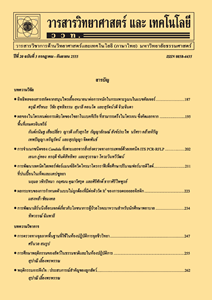ความสามารถของถั่วชนิดต่าง ๆ ในการต้านอนุมูลอิสระและส่งเสริมการเจริญเติบโตของแบคทีเรียแลคโตบาซิลลัส
Main Article Content
บทคัดย่อ
การศึกษาสมบัติในการเสริมสร้างสุขภาพของถั่ว 8 ชนิด ได้แก่ ถั่วดำ ถั่วเขียว ถั่วแดงหลวง ถั่วเหลือง ถั่วขาว ถั่วแดงอะซูกิ ถั่วเหลืองผิวดำ และถั่วแดงนาง โดยศึกษาความสามารถในการต้านอนุมูลอิสระ (DPPH radical-scavenging method, ABTS radical cation decolorization assay, ปริมาณสารประกอบฟีนอลิก และแอนโทไซยานิน) และส่งเสริมการเจริญเติบโตของจุลินทรีย์สุขภาพ (การวัดความขุ่น การนับจำนวนเซลล์ และ ปริมาณแป้งรีซิสแตนท์) พบว่าถั่วต่างชนิดกันมีความสามารถในการต้านอนุมูลอิสระที่ต่างกันอย่างมีนัยสำคัญ (p<0.05) ถั่วที่มีรงควัตถุเคลือบที่ผิว มีความสามารถในการต้านอนุมูลอิสระสูง มีปริมาณสารประกอบฟีนอลิก และแอนโทไซยานินสูง โดยเฉพาะถั่วดำและถั่วแดง เมื่อเปรียบเทียบความสามารถในการส่งเสริมการเจริญเติบโตของจุลินทรีย์สุขภาพทั้ง 3 สายพันธุ์ ได้แก่ Lactobacillus acidophilus TISTR 450, L. bulgaricus TISTR 451 และ L. casei TISTR 453 พบว่าจุลินทรีย์สุขภาพทั้ง 3 สายพันธุ์ สามารถใช้แหล่งคาร์บอนจากถั่วแต่ละชนิดแตกต่างกัน (p<0.05) สำหรับถั่วที่ใช้เป็นตัวอย่างทดลองทั้งหมดให้ผลการส่งเสริมการเจริญเติบโตของจุลินทรีย์สุขภาพใกล้เคียงกัน แต่พบสูงสุดในตัวอย่างถั่วแดงอะซูกิและถั่วแดงหลวง ซึ่งสอดคล้องกับปริมาณของแป้งรีซิสแตนท์ที่มีมากกว่าถั่วชนิดอื่น ๆ
คำสำคัญ : ถั่ว; ความสามารถในการต้านอนุมูลอิสระ; แป้งรีซิสแตนท์; แลคโตบาซิลลัส
Article Details
เอกสารอ้างอิง
[2] Lansky, E.P. and Newman, R.A., 2007, Punica granatum (pomegranate) and its potential for prevention and treatment of inflammation and cancer, J. Ethnophamacol. 19: 177-206.
[3] Alvira, D., Yeste-Velasco, M., Folch, J., Verdaguer, E., Canudas, A.M., Pallas, M. and Camins, A., 2007, Comparative analysis of the effects of resveratrol in two apoplotic models: Inhibition of complex I and potassium deprivation in cerebellar neurons, Neurosci. 147: 746-756.
[4] Sun, S.W., Yu, H.Q., Zhang, H., Zheng, Y.L., Wang, J.J. and Luo, L., 2007, Quercetin attenuates spontaneous behavior and spatial memory impairment in D-galactose-treated mice by increasing brain antioxidant capacity, Nutr. Res. 27: 169-175.
[5] Aryana, K.J. and McGrew, P., 2007, Quality attributes of yogurt with Lactobacillus casei and various prebiotics, LWT-Food Sci. Technol. 40: 1808-1814.
[6] Prescott, S.L. and Bjorksten, B., 2007, Probiotics for the prevention or treatment of allergic diseases, J. Allergy Clin. Immunol. 120: 255-262.
[7] Dai, Z., Su, D., Zhang, Y., Sun, Y., Hu, B., Ye, H., Jabbar, S. and Zeng, X., 2014, Immunomodulatory activity in vitro and in vivo of Verbascose from mung bean (Phaseolus aureus), J. Agric. Food Chem. 62: 10727-10735.
[8] Oomah, B.D., Corbe, A. and Balasubra-manian, P., 2010, Antioxidant and anti-inflamatory activities of bean (Phaseolus vulgaris L.) hulls, J. Agric. Food Chem. 58: 8225-8230.
[9] Elizabeth, R.N., Annete, H., Francisco, G.R., Javier, I.F., Graciela, Z. and Alberto, G.J., 2007, Antioxidant and antimutagenic activity of phenolic compounds in three different colour groups of common bean cultivars (Phaseolus vulgaris), Food Chem. 103: 521-527.
[10] Martinez, A.C., Pina, G.L. and Oomah, B.D., 2002, Antioxidant activity in common beans (Phaseolus vulgaris L.), J. Agric. Food Chem. 50: 6975-6980.
[11] Nahashon, S.N., Nakaue, H.S. and Mirosh, L.W., 1996, Performance of single comb white leghorn fed a diet supplemented with a live microbial during the growth and egg laying phases, Anim. Feed Sci. Technol. 57: 25-38.
[12] Su, P., Henriksson, A. and Mitchell, H., 2007, Selected prebiotics support the growth of probiotic mono-cultures in vitro, Anaerobe 13: 134-139.
[13] Carrera, E.C., Cruz, A.C., Guerrero, L.C. and Ancona, D.B., 2007, Effect of pyrodextrinization on available starch content of Lima bean (Phaseolus lunatus) and cowpea (Vigna unguiculata) starches, Food Hydrocoll. 21: 472-479.
[14] Tachibana, Y., Kikuzaki, H., Lajis, N.H. and Nakatani, N., 2001, Antioxidative activity of carbazoles from Murraya koenigii leaves, J. Food Eng. 80: 1255-1260.
[15] Re, R., Pellegrini, N., Proteggente, A., Pannala, A., Yang, M. and Evans, C.R., 1999, Antioxidant activity applying an improved ABTS radical cation decolorization assay, Free Radic. Biol. Med. 26: 1231-1237.
[16] Li, H.B., Cheng, K.W., Wong, C.C., Fan, K.W., Chen, F. and Jiang, Y., 2007, Evaluation of antioxidant capacity and total phenolic content of different fractions of selected microalgae, Food Chem. 102: 771-776.
[17] Fuleki, T. and Francis, F.J., 1968, Quantitative methods for anthocyanins. 1. Extraction and determination of total anthocyanin in cranberries, J. Food Sci. 33: 72-77.
[18] AOAC, 1998, Bacteriological Analytical Manual, 8th Ed., Association of Official Analytical Chemists, Gaithersburg, M.D.
[19] Madhujith, T. and Shahidi, F., 2005, Antioxidant potential of pea beans (Phaseolus vulgaris L.), J. Food Sci., 70(Nr.1): S85-90.
[20] Segev, A., Badani, H., Galili, L., Hovav, R., Kapulnik, Y., Shomer, I. and Galili, S., 2011, Total phenolic content and antioxidant activity of chickpea (Cicer arietinum L.) as affected by soaking and cooking conditions, Food Nutr. Sci. 2: 724-730.
[21] Yoshida, K., Sato, Y., Okuno, R., Kameda, K., Isobe, M. and Kondo, T., 1996, Structural analysis and measurement of anthocyanins from colored seed coats of Vigna, Phaseolus and Glycine Legumes, Biosci. Biotech. Biochem. 60: 589-593.
[22] Fabroni, S., Ballistreri, G., Amenta, M., Romeo, F.V. and Rapisarda, P., 2016, Screening of the anthocyanin profile and in vitro pancreatic lipase inhibition by anthocyanin-containing extracts of fruits, vegetables, legumes and cereals, J. Sci. Food Agric. 96: 4713-4723.
[23] Beninger, C.W. and Hosfield, G.L., 2003, Antioxidant activity of extracts, condensed tannin fractions, and pure flavonoids from Phaseolus vulgaris L. seed coat color genotypes, J. Sci. Food Agric. 51: 7879-7883.
[24] Bird, A.R., Conlon, M.A., Christophersen, C.T. and Topping, D.L., 2010, Resistant starch, large bowel fermentation and broader perspective of prebiotics and probiotics, Benef. Microbes. 1: 423-431.
[25] Reddy, C.K., Suriya, M. and Haripriya, S., 2013, Physico-chemical and functional properties of resistant starch prepared from red kidney beans (Phaseolus vulgaris L.) starch by enzymatic method, Carbohydr. Polym. 95: 220-226.
[26] Dangsungnoen, P., Moongngam, A. and Deeseenthum, S., 2012, Comparison of resistant starch content and survival of Lactobacillus spp. On four different sources of resistant starch, In Proceeding of 2012 International Conference on Life Science and Engineering, Singapore.
[27] Gänzle, M.G. and Follador, R., 2012, Metabolism of oligosaccharides and starch in lactobacilli: A review, Front. Microbiol. 3: 1-15.


